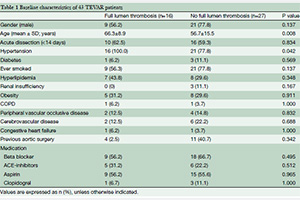Predictors of false lumen thrombosis in type B aortic dissection treated with TEVAR
Abstract
Background: Thoracic endovascular aortic repair (TEVAR) offers a less invasive treatment option in type B aortic dissection (TBAD) patients and its value has been demonstrated in acute and chronic dissection patients. Total false lumen thrombosis (FLT) is associated with better long-term outcome in these patients, however, this is not obtained in all patients. The purpose of this study was to investigate predictors of FLT.
Methods: We retrospectively investigated patients who underwent TEVAR for a type B dissection in a large referral center between 2005 and 2012. All patients with a CT angiogram (CTA) obtained preoperatively, postoperatively and after one year of follow-up were selected for analysis. Volume measurements and several morphologic characteristics were analyzed for all scans using Aquarius iNtuition software (TeraRecon, San Mateo, Calif, USA). Multivariate logistic regression analyses were used to study the influence of these characteristics on FLT.
Results: Of 132 patients that received TEVAR for an aortic dissection, 43 patients (mean age, 60.3±14.2; 30 male) met our inclusion criteria, of whom 16 (37%) developed full FLT after 1 yr of follow-up. Multivariate logistic regression showed that side branch involvement [odds ratio (OR), 0.03; 95% confidence interval (CI), 0.00-0.92; P=0.045] and a total patent false lumen (FL) at presentation (OR, 0.01; 95% CI, 0.00-0.58; P=0.027) were associated with decreased complete FLT. Volumetric data showed significantly more reduction of the thoracic false lumen in FLT patients compared with non-FLT (–52.3% vs. –32.4%; P=0.043) and also a tendency of less volume increase in the abdominal segment (–5.0±37.5 vs. 21.8±44.3; P=0.052).
Conclusions: Patients admitted with type B dissection and branch vessel involvement or a patent entry tear after TEVAR are less likely to develop FLT and aortic remodeling during follow-up. These findings suggest that these patients may require a more extensive procedure and more intensive follow-up to prevent longterm complications.
Cover






